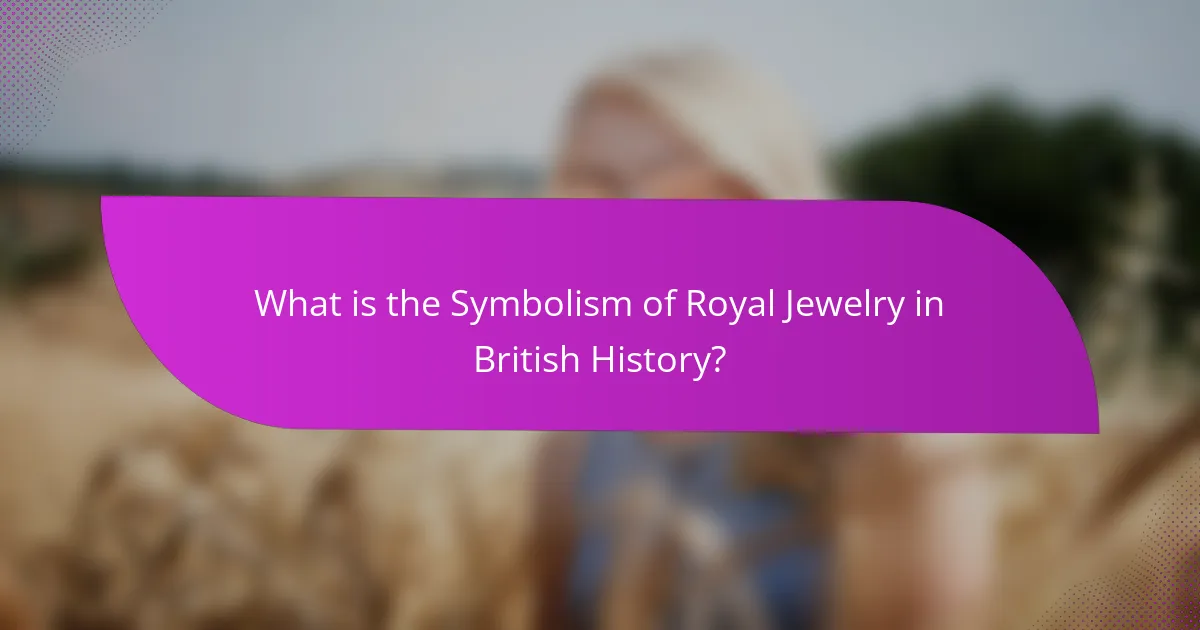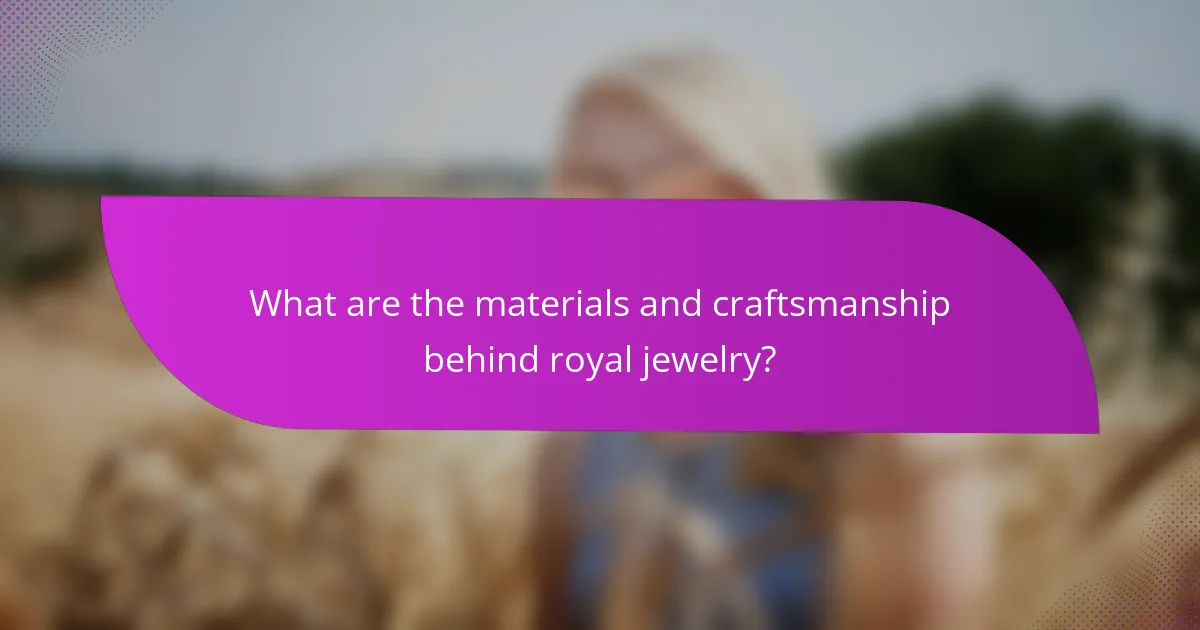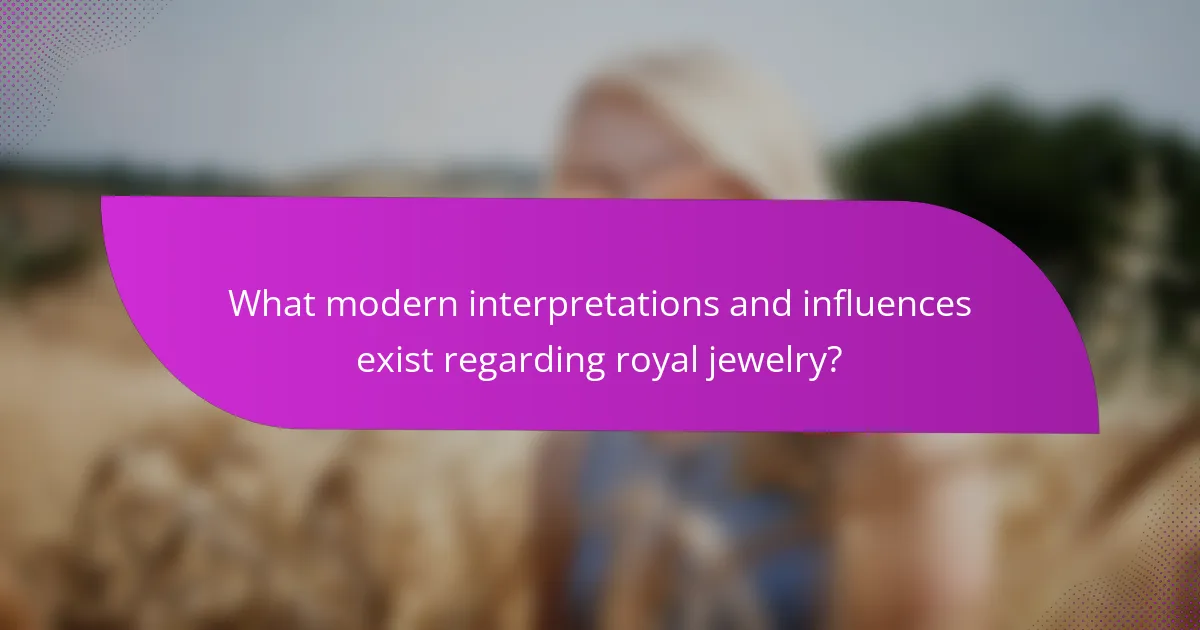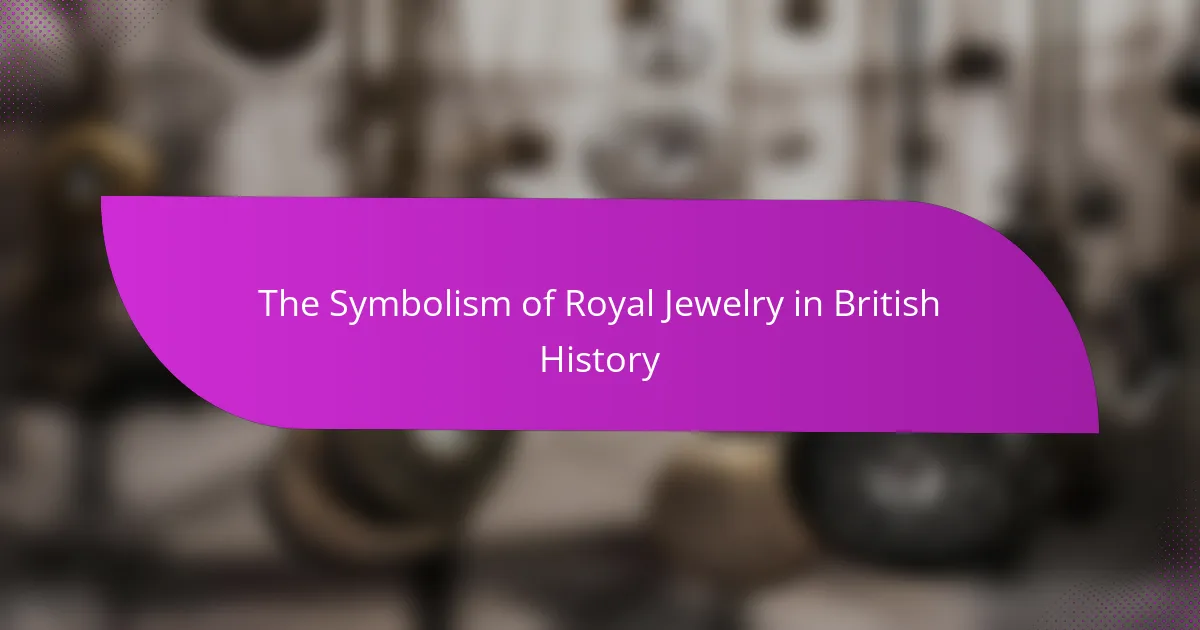Royal jewelry in British history serves as a powerful symbol of the monarchy’s authority, wealth, and status. Key pieces, such as the Crown Jewels, exemplify this opulence with their intricate designs and use of precious materials like gold, silver, and gemstones. The craftsmanship involved reflects high standards and skilled techniques that have been passed down through generations, connecting historical lineage to modern interpretations. Contemporary royal jewelry incorporates personal expression and sustainability, influenced by social media and current design trends. Overall, royal jewelry represents a rich tapestry of tradition, heritage, and evolving narratives within the British monarchy.

What is the Symbolism of Royal Jewelry in British History?
Royal jewelry in British history symbolizes power, wealth, and status. It serves as a representation of the monarchy’s authority. Historically, royal jewelry has been used in coronations and state ceremonies. The Crown Jewels, for instance, include items like the Imperial State Crown. This crown features over 3,000 gemstones, highlighting the monarchy’s opulence. Royal jewelry also signifies lineage and heritage. Many pieces are passed down through generations, connecting the past to the present. Additionally, certain jewels are associated with specific monarchs, reflecting their reigns and personal stories. Overall, royal jewelry embodies the rich history and traditions of the British monarchy.
How has royal jewelry represented power and authority throughout history?
Royal jewelry has historically represented power and authority by symbolizing wealth and status. It has been used as a tool for political alliances and displays of dominance. For example, crowns and tiaras adorned with precious gems signify royal lineage and governance. The British Crown Jewels, including the Imperial State Crown, are iconic representations of sovereignty. These items are often displayed during state ceremonies, reinforcing the monarchy’s authority. Additionally, royal jewelry has been gifted as a sign of loyalty and favor, further cementing relationships between rulers and their subjects. Throughout history, the opulence of royal jewelry has served to distinguish the elite from the common populace.
What specific symbols are commonly found in royal jewelry?
Common symbols found in royal jewelry include crowns, lions, and eagles. Crowns represent sovereignty and power. They are often embellished with precious stones. Lions symbolize bravery and strength, frequently appearing in heraldic designs. Eagles denote nobility and are used in royal crests. Other symbols include flowers, which signify beauty and growth, and crosses, representing faith. These symbols reflect the history and values of royalty. They are integral to the identity of royal families.
How do these symbols reflect the values of different historical periods?
Symbols in royal jewelry reflect the values of different historical periods by showcasing power, wealth, and cultural significance. For instance, during the Tudor period, jewelry often symbolized the monarch’s authority and divine right to rule. The use of gold and precious stones signified not only prosperity but also the stability of the monarchy. In the Victorian era, jewelry became a means of expressing personal sentiment and social status, with pieces often representing mourning or love. The introduction of more intricate designs mirrored the era’s emphasis on craftsmanship and artistry. Each period’s jewelry styles and motifs reveal societal values, including the importance of heritage, religion, and personal identity. Therefore, royal jewelry serves as a historical record of the evolving values within British society across time.
Why is royal jewelry significant in the context of British monarchy?
Royal jewelry is significant in the context of the British monarchy as it symbolizes power, heritage, and national identity. These pieces often contain precious materials and gemstones, representing wealth and status. Historically, royal jewelry has been used in ceremonies, such as coronations, reinforcing the monarchy’s authority. Specific items, like the Crown Jewels, hold immense historical value and are protected as national treasures. They connect the monarchy to British history and tradition, embodying the continuity of royal lineage. Additionally, royal jewelry often features intricate designs that reflect artistic craftsmanship and cultural heritage. Such pieces serve not only as adornments but also as powerful symbols of the monarchy’s role in society.
What role does royal jewelry play in state ceremonies and traditions?
Royal jewelry serves as a significant symbol in state ceremonies and traditions. It represents authority, continuity, and national identity. During coronations, royal jewelry, such as crowns and scepters, signifies the monarch’s power. Historical pieces often carry deep cultural and historical meanings. For instance, the Imperial State Crown is worn during the State Opening of Parliament. This highlights the connection between monarchy and governance. Additionally, royal jewelry is used in state banquets and diplomatic events. It reinforces the monarchy’s role in representing the nation. Overall, royal jewelry is integral to the ceremonial and symbolic aspects of British history.
How does royal jewelry influence public perception of the monarchy?
Royal jewelry significantly influences public perception of the monarchy by symbolizing power and tradition. The opulence of royal jewelry conveys a sense of wealth and authority. For instance, pieces like the Crown Jewels are steeped in history and represent national identity. Public appearances featuring royal jewelry often reinforce the monarchy’s status. Events such as state openings or royal weddings showcase these items, attracting media attention. This visibility shapes public opinion, often fostering admiration or criticism. Historical associations, like the use of specific jewels during significant events, further enhance their impact. Overall, royal jewelry acts as a tangible link between the monarchy and national heritage.
What are the different types of royal jewelry used in British history?
The different types of royal jewelry used in British history include crowns, tiaras, necklaces, brooches, and rings. Crowns are often worn during coronation ceremonies, symbolizing authority and sovereignty. Tiaras are typically worn by royal women at formal events, representing status and elegance. Necklaces, such as the Cambridge Emeralds, often showcase precious stones and royal lineage. Brooches have been used to convey personal messages or commemorate events, like the Queen’s Diamond Jubilee brooch. Rings, including the famous Imperial State Crown ring, signify commitment and power. Each piece of jewelry carries significant historical and cultural importance within the British monarchy.
What historical pieces are considered iconic in royal jewelry collections?
Iconic pieces in royal jewelry collections include the Crown Jewels of the United Kingdom. The Imperial State Crown is a prominent example, adorned with nearly 3,000 diamonds. Another significant piece is the Koh-i-Noor diamond, which has a storied history and is set in the Queen Mother’s Crown. The Stuart Sapphire, part of the Imperial State Crown, also holds historical importance. The Cambridge Emeralds, a collection of emeralds given to Queen Mary, are noteworthy as well. The Delhi Durbar necklace, created for Queen Mary, showcases the opulence of royal adornments. Each piece symbolizes power, heritage, and the royal family’s lineage. These items are often displayed during state ceremonies, reinforcing their cultural significance.
How have styles of royal jewelry evolved over the centuries?
Styles of royal jewelry have evolved significantly over the centuries. In the medieval period, royal jewelry featured religious symbols and gemstones. The Renaissance introduced intricate designs and elaborate motifs. The Baroque era emphasized opulence with large, ornate pieces. The Victorian era saw the rise of sentimental jewelry, often incorporating personal meanings. The Edwardian period favored delicate and lace-like designs, using platinum and diamonds. In the 20th century, modernism brought minimalist styles and innovative materials. Today, royal jewelry reflects a blend of tradition and contemporary aesthetics, showcasing both heritage and modern design elements. Each era’s style is influenced by cultural, social, and technological changes.
How does royal jewelry connect to British cultural identity?
Royal jewelry symbolizes British cultural identity through its historical significance and representation of monarchy. It embodies the continuity of tradition and heritage in British society. Items like the Crown Jewels serve as national treasures, showcasing craftsmanship and artistry. These pieces are often associated with royal ceremonies, reinforcing the monarchy’s role in public life. The jewelry reflects the values of loyalty, power, and unity, central to British identity. Historical events, such as coronations, further solidify their importance in national consciousness. Royal jewelry thus acts as a tangible link between the past and present, shaping cultural narratives in Britain.
What narratives do royal jewelry pieces tell about British heritage?
Royal jewelry pieces convey narratives of power, tradition, and identity within British heritage. These artifacts represent the lineage and authority of the monarchy. For instance, the Crown Jewels symbolize the historical continuity of the British monarchy. They are used in significant ceremonies, reinforcing royal legitimacy. The materials, often precious stones and gold, signify wealth and status. Specific pieces, like the Imperial State Crown, carry stories of past monarchs and their reigns. Each item often has a unique history tied to events in British history. Thus, royal jewelry is not merely decorative; it embodies the essence of British cultural heritage.
How does royal jewelry contribute to national pride and identity?
Royal jewelry contributes to national pride and identity by symbolizing a nation’s heritage and continuity. It embodies the history and traditions of a country, often linked to significant events and figures. For example, the Crown Jewels of the United Kingdom are not only valuable but also represent the monarchy’s authority and the nation’s legacy. These pieces are displayed during important ceremonies, reinforcing national unity and pride. The craftsmanship and design of royal jewelry often reflect the artistic achievements of a culture. Additionally, royal jewelry serves as a source of inspiration and national storytelling, fostering a collective identity among citizens.

What are the materials and craftsmanship behind royal jewelry?
Royal jewelry is crafted from precious materials such as gold, silver, and platinum. These metals provide durability and a luxurious appearance. Additionally, gemstones like diamonds, emeralds, and sapphires are commonly used. These stones are valued for their rarity and brilliance.
The craftsmanship of royal jewelry involves intricate design and skilled techniques. Artisans often employ methods like filigree, engraving, and enameling. Each piece is typically handmade, ensuring uniqueness and attention to detail. Historical records indicate that royal jewelers adhered to high standards, often taking months or years to complete a single piece.
Notable examples include the Crown Jewels of the United Kingdom, which feature both exceptional materials and craftsmanship. These pieces are not only ornamental but also hold significant historical and cultural value.
What materials are traditionally used in royal jewelry?
Gold, silver, and precious gemstones are traditionally used in royal jewelry. Gold is valued for its durability and luster. Silver is often used for its elegance and affordability. Precious gemstones include diamonds, rubies, emeralds, and sapphires. These stones symbolize power and wealth. Historically, royal jewelry has showcased these materials to reflect status. The Crown Jewels of the United Kingdom exemplify this tradition. They feature gold and numerous gemstones, highlighting their significance in royal symbolism.
How do the materials chosen reflect the status of the wearer?
The materials chosen for royal jewelry reflect the status of the wearer through their rarity and value. Precious metals like gold and platinum signify wealth and power. Gemstones such as diamonds, emeralds, and sapphires are often used due to their scarcity and high market value. Historically, royal jewelry has incorporated materials that are not only expensive but also difficult to obtain. For example, the Crown Jewels of the United Kingdom feature some of the largest diamonds in the world, emphasizing the monarchy’s wealth and prestige. The choice of materials also conveys cultural significance, as certain gems and metals are associated with specific royal families or historical events. Thus, the materials serve as a visual representation of the wearer’s social standing and influence.
How is craftsmanship important in the creation of royal jewelry?
Craftsmanship is essential in the creation of royal jewelry as it ensures quality and artistic expression. High-level craftsmanship involves intricate techniques and attention to detail. These skills allow artisans to create unique pieces that reflect royal heritage. Historical examples, such as the Crown Jewels, showcase exceptional craftsmanship. Each piece is meticulously designed to symbolize power and prestige. The use of precious materials further highlights the importance of craftsmanship. Fine jewelry pieces often carry historical significance and are passed down through generations. Thus, craftsmanship plays a crucial role in the value and legacy of royal jewelry.
What techniques are used by artisans to create royal jewelry pieces?
Artisans use various techniques to create royal jewelry pieces. These techniques include intricate metalworking, gemstone setting, and enameling. Metalworking involves shaping and joining precious metals like gold and silver. Gemstone setting requires precise placement of diamonds, rubies, and other gems. Enameling adds color and design through glass-like coatings.
Additionally, filigree work showcases delicate patterns made from thin metal threads. Engraving creates detailed designs on surfaces, enhancing visual appeal. The use of cloisonné involves forming compartments with metal strips to hold colored enamel.
Historical examples include the Crown Jewels of the United Kingdom, which feature these techniques. The craftsmanship reflects centuries of tradition and skill in royal jewelry making.
How does the craftsmanship of royal jewelry compare to contemporary jewelry?
The craftsmanship of royal jewelry is often more intricate and traditional compared to contemporary jewelry. Royal jewelry typically features elaborate designs, using high-quality materials and gemstones. Artisans often spend years perfecting techniques passed down through generations. For instance, the Crown Jewels of the United Kingdom showcase exceptional craftsmanship, with pieces like the Imperial State Crown made from gold and encrusted with nearly 3,000 diamonds. In contrast, contemporary jewelry often emphasizes minimalism and modern design, focusing on accessibility and versatility. Many contemporary pieces are mass-produced, leading to variations in quality and craftsmanship. Overall, royal jewelry reflects a deep historical significance and artisanal dedication not always matched in contemporary styles.

What modern interpretations and influences exist regarding royal jewelry?
Modern interpretations of royal jewelry often emphasize personal expression and cultural significance. Contemporary designers draw inspiration from historical pieces while incorporating modern aesthetics. For example, Meghan Markle’s engagement ring features a unique design that blends tradition with individuality. This reflects a shift towards personalization in royal jewelry choices. Social media also influences how royal jewelry is perceived and showcased. Platforms allow for real-time sharing and commentary on royal appearances. Additionally, sustainability trends impact modern jewelry design, with an increasing focus on ethical sourcing. The blending of heritage and modernity is evident in exhibitions showcasing royal collections. These exhibitions attract diverse audiences, highlighting the evolving narrative of royal jewelry.
How do current royal family members use jewelry to convey messages?
Current royal family members use jewelry to convey messages of status, heritage, and personal sentiment. Jewelry often symbolizes national pride, with pieces featuring national emblems or colors. For example, the Queen often wore brooches with specific meanings during public engagements. These choices reflect her connection to historical events or personal milestones. Family heirlooms are frequently worn to honor lineage and tradition. Additionally, contemporary royals utilize jewelry to express solidarity with social causes. For instance, wearing pieces from ethical sources highlights their commitment to sustainability. Overall, jewelry serves as a powerful medium for conveying complex messages in royal contexts.
What modern pieces have been inspired by historical royal jewelry?
Modern pieces inspired by historical royal jewelry include the Queen Mary Diamond Bandeau, replicated by various jewelers. The bandeau features a floral design with diamonds, similar to the original worn by Queen Mary. Another example is the Cambridge Lover’s Knot Tiara, which has inspired contemporary designs in bridal jewelry. The use of sapphires and pearls in modern pieces reflects the iconic styles of royal jewelry. Designers often reference the intricate craftsmanship seen in royal pieces. The influence of royal jewelry is evident in both high fashion and accessible collections. These modern interpretations maintain the elegance and significance of their historical counterparts.
What lessons can be drawn from the symbolism of royal jewelry?
Royal jewelry symbolizes power, status, and heritage. It reflects the wealth and influence of monarchs throughout history. Each piece often carries specific meanings tied to national identity or royal lineage. For instance, the British Crown Jewels represent the authority of the monarchy. They are used in significant ceremonies, reinforcing the connection between the crown and the nation’s history. Additionally, royal jewelry often showcases exceptional craftsmanship and artistry. This highlights the cultural values and traditions of the time. The symbolism also serves to unite the monarchy with the public, fostering a sense of national pride. Overall, royal jewelry teaches us about the interplay between art, identity, and power in society.
How can understanding royal jewelry enhance appreciation for cultural heritage?
Understanding royal jewelry enhances appreciation for cultural heritage by showcasing historical significance and craftsmanship. Royal jewelry often reflects the values and traditions of a culture. Each piece can symbolize power, status, and identity. For instance, the British Crown Jewels represent centuries of monarchy and national pride. Their intricate designs highlight exceptional artistry and material value. Historical events, such as coronations, are often intertwined with these jewels. This connection fosters a deeper understanding of a nation’s narrative. Additionally, royal jewelry serves as a tangible link to past generations. It allows individuals to explore cultural evolution through fashion and symbolism.
What tips can help individuals incorporate royal jewelry symbolism into personal style?
To incorporate royal jewelry symbolism into personal style, individuals can select pieces inspired by historical designs. Look for jewelry that features motifs like crowns, crests, or floral patterns, reflecting royal heritage. Choose gemstones associated with royalty, such as sapphires or emeralds, to evoke a sense of elegance. Layering necklaces or stacking rings can create a regal look while maintaining modern sensibilities. Incorporating vintage or antique pieces can provide authenticity and connection to history. Lastly, consider wearing jewelry during significant occasions to enhance the symbolic meaning of the pieces. These strategies allow personal expression while honoring the rich tradition of royal jewelry symbolism.
The main entity of this article is royal jewelry in British history, which symbolizes power, wealth, and status within the monarchy. The article explores how royal jewelry represents authority through its use in ceremonies and its connection to lineage and heritage. It discusses common symbols found in royal jewelry, the evolution of styles over time, and the significance of materials and craftsmanship. Additionally, the article highlights the role of royal jewelry in shaping public perception of the monarchy and its contribution to national pride and identity. Finally, it examines modern interpretations and the lessons drawn from the symbolism of royal jewelry.
